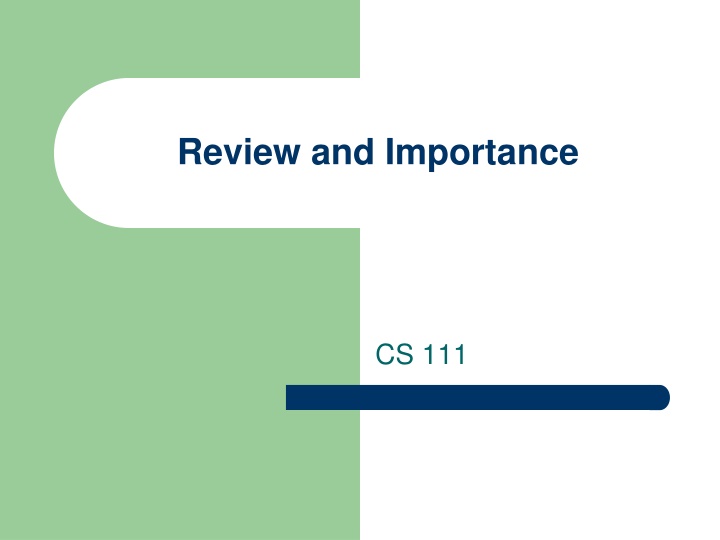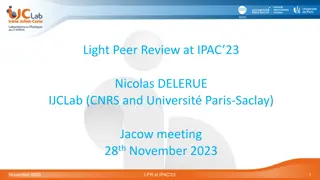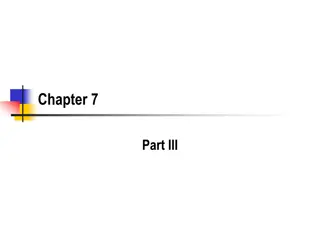
Advanced Concepts in Signal Processing
Explore the in-depth concepts of signal processing in CS-111, covering analog vs. digital signals, linear system properties, convolution algorithms, edge detection methods, spectral analysis, non-linear filters, histogram analysis, and more.
Download Presentation

Please find below an Image/Link to download the presentation.
The content on the website is provided AS IS for your information and personal use only. It may not be sold, licensed, or shared on other websites without obtaining consent from the author. If you encounter any issues during the download, it is possible that the publisher has removed the file from their server.
You are allowed to download the files provided on this website for personal or commercial use, subject to the condition that they are used lawfully. All files are the property of their respective owners.
The content on the website is provided AS IS for your information and personal use only. It may not be sold, licensed, or shared on other websites without obtaining consent from the author.
E N D
Presentation Transcript
Review and Importance CS 111
Signals Analog vs Digital Sampling Nyquist Sampling Theorem Quantization Artifacts Generalization to higher dimensions
Linear System Properties Homogeneity Additivity Shift Invariance Helps Decompose Analyze Combine
Convolution Basic Algorithm Linear System Properties Commutative Associative Distributive
Linear Filters Low pass Filters Gaussian Pyramids High pass filters Band pass filters Laplacian Pyramids Combining linear filters Designing new filters
Edge Detection Edgel detection Gradient based operators Curvature based operators Advantages and disadvantages Multi-resolution edge detection Higher level representation Hough Transform
Spectral Analysis of Signals Discrete Fourier Transform Analysis Using Correlation Sythesis Weight Addition of sinusoidal Basis Interpretation of amplitude and phase plot 1D and 2D Repetative nature
Spectral Analysis of Signals Properties Homogeneity Additivity Spatial shift corresponds to phase shift Symmetry and linearity of phase Duality Convolution vs Multiplication Expansion vs Compression
Spectral Analysis of Signals Applications Amplitude Modulation Frequency Modulation Filter Design Fourier Pairs Implication of Duality Aliasing Sampling and Reconstruction
Non-Linear Filters Self Similarity Feature detectors Isotropism Order statistics filters Median filter
Histogram Analysis Definition Histogram Stretching Global Local Contrast Enhancement Histogram Equalization
Color Properties of spectrum Intensity, brightness, hue, satuaration Additive vs Subtractive color CIE XYZ space Metamerism Chromaticity Chart Relating to perceptual quantities Computations of I, x, y, Y
Color Reproducibility Color Gamuts Tone mapping operators Dithering Color management in additive devices Device Specifications Gamut transformation and matching Color management in subtractive devices Non-linearity of devices and methods
Color Image Processing Image composition Replace Blend Feather Blending Width Smoothness of function Pyramid blending
Geometric Transformation Linear Transformations Homogeneous Coordinates Finding unknown transformations Using correspondences Non-linear transformations Interpolation Techniques Forward vs Backward Interpolation
Compression Technique General Techniques Simple LSB rejection Statistical CLUT, Huffman coding, run-length encoding Interpolation based Transform based Motivation:Contrast Sensitive functions
JPEG Compression Pipeline How is transform used? How is interpolation used? How is statistics used? How are the DCT blocks encoded? How the quantization table changes quality of compression?
Morphological Operators (Binary) Erosion Dilation Opening Closing Properties
Morphological Operators (Gray Scale) Extension of binary Morphological smoothing Morphological Edge detection Morphological Noise filter Applications Object detection Texture segmentation Removal of debris






















